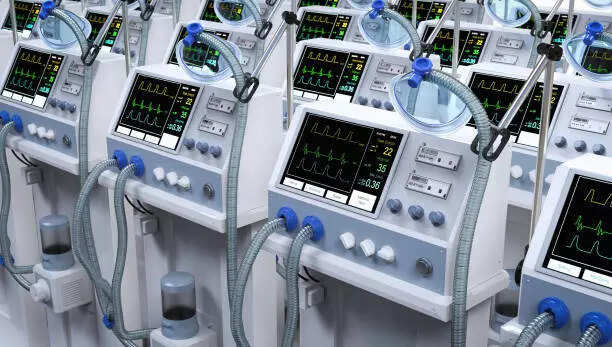
New Delhi: As the US sharpens its trade arsenal under Donald Trump’s second term, the Indian medical device sector has been thrust into the crossfire. With sweeping tariffs signaling a shift from free trade to fierce protectionism, India’s MedTech industry—poised for exponential growth—now faces a critical inflection point.
Experts warn that while US tariff tactics may boomerang, India can’t afford complacency. Fixing domestic gaps and strategically navigating the China factor is now mission-critical to protect its MedTech dreams.
While the “Liberation Day” announcement has been put on hold for 90 days (except for China), the 10 per cent baseline duty has already disrupted the long-standing global economic order based on free trade and open market access. The move is pushing policymakers and industry stakeholders to recalibrate their strategies and explore alternative safe passages.
Ironically, just as India’s medical device sector stands on the cusp of transformative growth—where the US has long been considered the default partner to realize these ambitions—the latest announcements have sent ripples across the industry. Further compounding uncertainty are reports that the ongoing bilateral trade deal negotiations might offer better tariff support for US device exports.
To understand the implications of these developments and the shifting trade winds for India’s MedTech ambitions, ETHealthworld hosted a webinar titled “Tariffs, Trade Winds & the MedTech Dream: Can India Weather the Storm?” The discussion focused on how Indian manufacturers can remain resilient and competitive in a rapidly evolving trade landscape, balancing growth aspirations with regulatory and financial pressures.
The panel featured Rajiv Nath, Managing Director, Hindustan Syringes & Medical Devices Ltd, and Forum Coordinator, Association of Indian Medical Device Industry (AiMeD), Dr. Jitendra Sharma, MD & Founder CEO, Andhra Pradesh MedTech Zone (AMTZ), Pavan Choudary, Chairman, Medical Technology Association of India (MTaI)
and Ganesh Sabat, Non-Executive Director, Sahajanand Medical Technologies (SMT)
Rajiv Nath opened the discussion, stating, “The 10 per cent price increase presents a short-term challenge. Companies are under pressure to either absorb the hike or share it with consumers in a 50:50 ratio. Moving forward, different companies will negotiate based on varying terms and capacities.”
He added that, in a recent meeting, the Minister of Commerce and Industry, Piyush Goyal, advised that buyers may have to take the hit themselves, and manufacturers should not expect government support or subsidies to offset such losses.
From a global manufacturer’s lens, Choudary noted that stakeholders are reviewing past precedents while waiting for the situation to stabilize. “Deal sizes and flows have slowed. Uncertainty is forcing a more measured approach to investments,” he said.
Dr Sharma emphasised that every trade barrier creates an impact—but the damage varies by company size and scale. “If this escalates into a reciprocity-driven response, and bilateral trade dips by 10–20 per cent, US exports to India—worth around $1.5 billion—could take a larger hit than India’s exports to the US, which are at $713 million,” he explained.
Ganesh Sabat added that, until now, Chinese companies have been undercutting Indian manufacturers in the US. But under the new tariff regime—where Chinese products face duties up to 145 per cent compared to the proposed 26 per cent for Indian goods—Indian firms have a strategic window to regain competitiveness.
Non-Tariff Barriers: The Bigger Beast?
Despite this short-term tariff advantage, Nath pointed out that non-tariff barriers remain the real hurdle. “When the USFDA flagged concerns about quality in Chinese goods and tariffs were introduced, companies didn’t necessarily relocate to India—they went to Vietnam and Malaysia. That’s telling,” he remarked.
Meanwhile, Chinese companies, restricted from entering the US market, have been dumping goods into regions with lower tariffs, such as West Asia and North Africa (WANA). Over the past six months, India has also seen a 33 per cent surge in Chinese imports—especially in 11 product categories like diagnostic reagent kits, which alone saw a 23 per cent increase.
Choudary cautioned, “Apart from US-India bilateral dynamics, we must closely watch China, which may strike strategic new trade deals and undercut India in global markets. Unlike the US’s posturing, China tends to pursue more substantive, long-term measures.”
On passing on cost hikes to consumers, Sabat said, “The strategy is segment-specific. In categories with multinational competition, Indian players may be forced to absorb costs if others offer lower prices.”
The panel also flagged that the US administration has warned against any backdoor arrangements aimed at rerouting Chinese goods through third-party nations.
Opportunities on the Horizon
“India has the opportunity to reclaim a significant portion of the ₹12,000 crore market currently dominated by Chinese imports,” said Dr Sharma.
He further highlighted untapped potential in Russia. “Since the Ukraine conflict, Russia is replacing European medical imports with Chinese products. India has already expanded its oil trade with Russia—why not healthcare next?”
Dr Sharma underscored the urgent need to develop a resilient domestic supply chain, saying, “We cannot continue to rely on two countries—US and China—for 40–45 per cent of our imports. That’s economically unsustainable.”
Concluding the discussion, Nath asserted, “A Free Trade Agreement (FTA) between India and the US is unlikely. A Bilateral Trade Agreement (BTA) seems more realistic—and the eventual deal may serve as a template for US negotiations with other countries.”